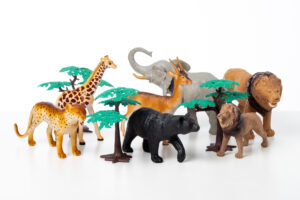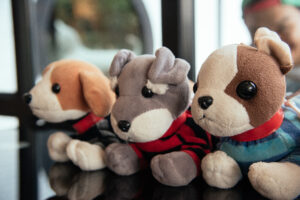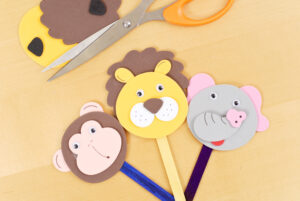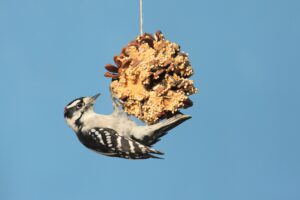11 Fun Animal Activities That Encourage Early Language & Literacy Skills
September 15, 2022
Kids love animals—and that’s why animal activities are a great way to expand young children’s early language and literacy skills. Today’s blog post brings you 11 creative activities early educators can use to teach new vocabulary words, reinforce correct grammar constructions, and encourage talk with teachers and peers. Adapted from classic Brookes books, these critter-centric games and play motifs will boost key skills while little learners have fun!
Farm Fun
Have young learners act out the different activities associated with caring for farm animals. Designate barn and corral areas in your classroom, and gather toys that represent farm animals to care for, such as cows, horses, pigs, and chickens. Facilitate role play and promote language and literacy skills by talking with children about different farm activities (“I am feeding the hay to the cow. Do you want to help me?”), providing a sentence and asking for the missing word (“This bucket is empty, and this bucket is _____ (full),” and expanding on children’s speech to model correct grammar (if a child says “Him big,” say “He is a big horse”).
What a Zoo!
Create a zoo in your classroom with a variety of animal toys in defined spaces—for example, use field areas for large animals, a cardboard cutout of a pond for ducks, a small baby pool for bears or penguins. Some children  could pretend to be visitors to the zoo—they can buy a ticket, look at the animals, and purchase food and souvenirs with play money. Other children could be workers at the zoo, taking care of the animals, feeding them, and selling food and mementos. Strengthen language skills during this activity by modeling phonological awareness (“Lion and like both start with the letter L”), introducing new vocabulary (“A baby elephant is called a calf”), and reinforcing concepts like color and size (“The baby monkey is small, and the daddy monkey is large”).
could pretend to be visitors to the zoo—they can buy a ticket, look at the animals, and purchase food and souvenirs with play money. Other children could be workers at the zoo, taking care of the animals, feeding them, and selling food and mementos. Strengthen language skills during this activity by modeling phonological awareness (“Lion and like both start with the letter L”), introducing new vocabulary (“A baby elephant is called a calf”), and reinforcing concepts like color and size (“The baby monkey is small, and the daddy monkey is large”).
Animal Classification
Designate a farm area in your classroom (such as a toy barn with a toy fence) and a zoo area (such as a plastic or cardboard mat with zoo scenes drawn on it). Tell the children in your class that they are going to put the farm animals by the barn and the zoo animals in the zoo. Distribute different toy animals to the children and have them come up one at a time to identify their animal and decide whether it belongs on the farm or at the zoo. As an extension, you can also ask children to think of other animals that are not among the toys and tell the group where those animals live.
 Pet Store
Pet Store
Set up a pretend pet store with a variety of stuffed animals, such as dogs, cats, birds, hamsters, turtles, and fish. Children can be customers or workers in the store, caring for the pets by feeding and grooming them. Pretend pet food, leashes, collars, and pet toys can also be sold at the pet store (making signs/labels for the items and reading them together can help expand early literacy skills). A clerk can ring up sales on a cash register and be given money for the purchases.
Jungle Safari
Set up a mock jungle with palm trees, vines, and a river, along with stuffed animals to inhabit it. With two rows of chairs, you can create a pretend safari van to take children on tours. They can take pictures of the animals, pretend to be the animals, or be the tour guides and tell tourists all about the animals they see. Model language elements like vocabulary words and rhymes: “The jungle has very thick vines,” “The words green, seen, and mean all rhyme.”
Creature Campout
Have children act out a camping trip where they look for animals that live in the forest. Talk about the forest  animals that children might see on a hike, and then take a hike around the classroom or playground to spot different animals. You might have a pretend bear cave with stuffed bears in it, a stuffed raccoon behind a tree, and some birds perched around. After the hike, talk about the animals you saw and ask children open-ended questions. Children can put up tents with bedsheets or unroll sleeping bags and pretend to go to sleep after a long day of adventure.
animals that children might see on a hike, and then take a hike around the classroom or playground to spot different animals. You might have a pretend bear cave with stuffed bears in it, a stuffed raccoon behind a tree, and some birds perched around. After the hike, talk about the animals you saw and ask children open-ended questions. Children can put up tents with bedsheets or unroll sleeping bags and pretend to go to sleep after a long day of adventure.
Animal Role Play
Animals easily capture the imaginations of children. First, read your young learners books that invite them to pretend to be animals or to imitate their movements. As you try out a turtle’s crawl or a lion’s strut together, get kids talking about what they’re doing and feeling. If your classroom has a computer, you can look up more information on the children’s favorite animals and talk about how they behave and communicate.
Animal Puppets
Puppets are great for pretend fun and language practice. Have children make their own puppets of their favorite animals. Show them how to draw the animal on cardboard and attach a Popsicle stick, paint-stirring stick, or  chopstick for a handle. Or give them paper bags that they can draw animal faces on and demonstrate how to put a hand up into the folds to make the animal “talk.” Encourage the kids to talk to each other through the puppets using their best animal voices.
chopstick for a handle. Or give them paper bags that they can draw animal faces on and demonstrate how to put a hand up into the folds to make the animal “talk.” Encourage the kids to talk to each other through the puppets using their best animal voices.
Critter Picnic
Have the children bring in favorite stuffed animals for a picnic (be sure to have extras on hand for kids who forget or don’t have a stuffed animal). Pack a separate basket with a blanket, napkins, pretend food, and plastic plates and teacups for all the animals. Have snack on the floor and encourage the kids to “feed” their animals. Ask the children to talk about their animals and share stories about them.
Guess the Animal
This is a fun game for the whole class. Cut pictures of animals from a magazine, turn the pictures face down, and have one child choose a picture. The other kids can ask yes-or-no questions to guess what the animal is: “Does the animal swim? Is it bigger than a cat?” After someone guesses correctly, another person chooses a picture and lets the others guess.
 Bird Café
Bird Café
A classic activity children love! Give each child in your class a medium pinecone or dried corncob. Have the children use a plastic knife to spread peanut butter on it. Roll it in bird seed, sunflower seeds, or crushed granola. Hang your creations on a string outside your classroom window, or have the kids hang them up at home if possible. Observe the birds that come to your Bird Café and talk about how they look, what color they are, and what they sound like. Or have children share what birds they observed at home during circle time.
For more activities that encourage language and literacy skills—and expand other skills critical to classroom success and healthy child development—get the books behind today’s blog post:
- Activities 1-6: Adapted from Early Literacy in Action by Betty H. Bunce
- Activity 7: Adapted from Talk to Me, Baby! by Betty Bardige
- Activities 8-11: Adapted from ASQ®-3 Learning Activities by Elizabeth Twombly and Ginger Fink




Write a Comment
Your email address will not be published. Required fields are marked *
Post a Comment